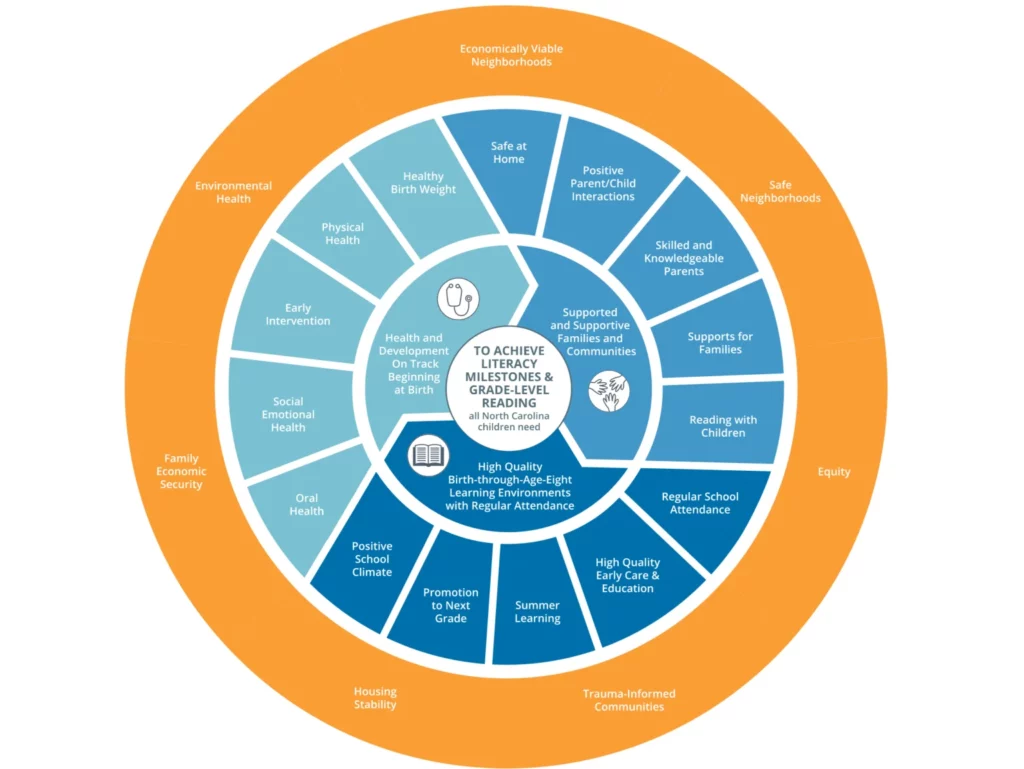
The full Pathways Action Map and the Pathways Data Dashboard, its companion tool, are now accessible.
The map provides detailed information about initiatives across the state whose work advances a shared vision where all North Carolina children, regardless of race, ethnicity, or socioeconomic status, are reading on grade-level by the end of third grade, while the data dashboard includes data on more than 60 measures of child development that research shows influence third-grade reading scores.
Combining data & policy
The Pathways to Grade Level Reading Initiative foregrounds the importance of harnessing data and policy to advance the shared vision of early childhood literacy for all North Carolina children, through two tools: The Pathways Data Dashboard and Action Map.
Digging into the Pathways Data Dashboard

The Pathways Data Dashboard supports a statewide effort to improve the collection, analysis, and use of early childhood data in NC for young children, birth to age eight. Within the tool, over 60 measures are organized into three goal areas that research shows are critical for improving children’s early literacy:
- Children’s health and development.
- Supported and supportive families and communities.
- High-quality birth-through-age-eight learning environments, with regular attendance.
The dashboard shares detailed data on third grade reading scores in NC, as well as data on the community conditions in which children live that influence child outcomes — such as family economic security, housing stability, environmental health, and safe and economically-viable neighborhoods.
The dashboard is designed to be interactive and adaptable to users’ needs. You will find interactive graphs and maps, as well as dropdown menus that enable you to select outcomes and tailor graphs to display the data of most interest. Updated regularly, it can be used by state and local policymakers, government agencies, community service providers, child advocacy organizations, and others to make data-informed decisions about investments in early childhood.
Concluding release of NC Pathways Action Map
Initiatives on the Pathways Action Map are organized into the four Expectation Areas illustrated below: Expectation 1 (Family-Driven and Equitable Systems), Expectation 2 (Family & Community Context), Expectation 3 (Education System), and Expectation 4 (Social-Emotional Health).
Highlighting initiatives advancing the literacy effort
This final release of the Pathways Action Map — though it will be continually updated — includes initiatives addressing broader societal and systemic issues that impact early childhood literacy, categorized under Expectation 2. Examples of featured initiatives include:
- Child Care Health Consultation
- Reach Out and Read
- Charlotte Bilingual Preschool
- Family Forward NC
- Think Babies™ NC
- Resilient NC
- HealthySteps
- ourBRIDGE
Check out the map to learn what counties these initiatives are working in, how they’re centering racial equity and community voices, what kind of impact they make, and how you may be able to plug in.
Join us in adding to the Action Map
Visit our info page to learn more about the Action Map and consider adding your work. Share it with others in your network and community, whose work you think should be spotlighted. We want to utilize the Map as a resource to build awareness of innovation, make connections, and identify gaps and opportunities that can help guide policymaking, advocacy, funding, and capacity building.
If you have any questions, or would like a guided tour of the Map, please contact us. We’d love to hear your ideas on how to continue to utilize this tool to support the success of all North Carolina children.
The NC Early Childhood Foundation is driven by a bold — and achievable — vision: Each North Carolina child has a strong foundation for life-long health, education, and well-being supported by a comprehensive, equitable birth-to-eight ecosystem. We build understanding, lead collaboration, and advance policies to ensure each North Carolina child is on track for lifelong success by the end of third grade.
Recommended reading



